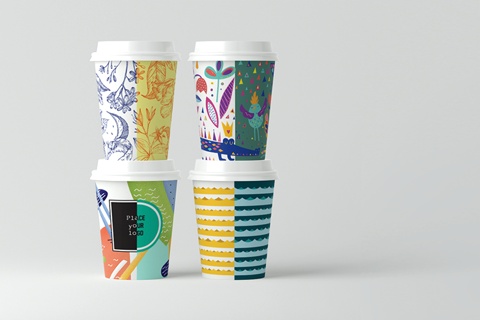
Sustainable packaging is becoming more important with growing awareness of environmental issues. Disposable cups are widely used, but their material choice plays a big role in reducing waste and pollution. Choosing eco-friendly materials not only supports the environment but also creates a positive image for businesses.
The Need for Eco-Friendly Alternatives
Disposable cups are used daily in cafes, offices, and events. Most traditional options are made with plastic or wax-coated paper, which are difficult to recycle. These cups often end up in landfills, where they take years to break down. Some even release harmful chemicals into the soil and water.
Eco-friendly alternatives address this problem by using materials that are either recyclable, compostable, or biodegradable. Switching to such materials helps reduce carbon emissions and supports waste management systems. Consumers today are also more conscious about what they use. They prefer businesses that take responsibility for the planet.
Governments across the world are also implementing strict rules against single-use plastics. By using sustainable cup materials, businesses can avoid penalties and improve compliance with environmental standards. This shift is not only beneficial for nature but also for long-term growth.
A brand that chooses eco-friendly disposable cups gains trust and respect from customers. People feel good when they buy coffee or beverages in packaging that does not harm the environment. This emotional connection drives loyalty and positive word-of-mouth.
The Role of Branding in Eco-Friendly Cups
Eco-friendly disposable cups are not just about materials. They are also a way to promote sustainability through branding. Companies can print messages, logos, and designs that highlight their green initiatives.
Customers notice these details. When they see a business using sustainable cups, they associate the brand with care and responsibility. This emotional connection builds loyalty and increases sales.
Some businesses even share stories about their eco-friendly journey on the cups. For example, they might explain how switching to bamboo or bagasse reduces waste. This makes customers feel part of a bigger movement.
Businesses that want to create lasting impressions can also explore services like https://ibexpackaging.com/custom-cups/, which provide high-quality designs for sustainable cups. This way, they combine functionality, beauty, and responsibility in one product.
Paper Cups with Plant-Based Linings
Traditional paper cups are lined with plastic films to prevent leakage. However, this plastic makes them hard to recycle. New eco-friendly solutions now replace plastic with plant-based materials. The most common one is polylactic acid (PLA), which is made from cornstarch or sugarcane.
PLA-lined paper cups are biodegradable and compostable under industrial conditions. This means they can break down much faster than traditional options. They also produce fewer greenhouse gases during production. Since they are plant-based, they reduce dependence on fossil fuels.
These cups are safe for hot and cold drinks, making them versatile. Many coffee shops and restaurants have started adopting them. The biggest advantage is that they look and feel just like regular cups. Customers can enjoy their drinks without worrying about harmful impacts.
One challenge is that composting facilities are not available everywhere. But as demand increases, more facilities are being built. In the meantime, businesses can still promote the eco-friendly nature of these cups as part of their sustainability commitment.
Bamboo Fiber Cups
Bamboo is one of the fastest-growing plants in the world. It requires little water, no pesticides, and grows naturally in many regions. Bamboo fibers are being used to make strong and durable disposable cups.
Bamboo fiber cups are fully biodegradable and compostable. They break down within a few months, leaving no toxic residue. This makes them a perfect option for eco-friendly packaging. They also have a natural texture and appearance that appeals to consumers who care about nature.
The strength of bamboo fibers allows cups to hold both hot and cold beverages. They are resistant to soaking and provide a good user experience. Since bamboo is renewable, using it reduces the pressure on forests. This helps preserve biodiversity and reduces deforestation.
Bamboo cups also offer businesses a unique look. They can be printed with eco-friendly inks to display creative designs. Many brands use bamboo packaging to stand out in the market. Customers often see bamboo products as premium, which adds value to the brand.
Sugarcane Bagasse Cups
Bagasse is the fibrous byproduct left after sugarcane is processed for juice. Instead of throwing it away, manufacturers use it to make eco-friendly products, including disposable cups.
Bagasse cups are 100% biodegradable and compostable. They naturally decompose in about 90 days, making them one of the best options for reducing waste. These cups are heat resistant, oil resistant, and suitable for both hot and cold beverages.
Using bagasse is a smart way to recycle agricultural waste. It turns something that would normally be discarded into a useful product. This supports the idea of a circular economy, where waste materials are reused rather than wasted.
Another benefit is that bagasse cups are sturdy and lightweight. They do not leak or get soggy, which makes them ideal for long use. Many eco-conscious cafes and food businesses are already switching to this option.
Cornstarch-Based Cups
Cornstarch is another renewable material that can be turned into eco-friendly cups. When processed, it produces a material called polylactic acid (PLA). As mentioned earlier, PLA is biodegradable and compostable.
Cornstarch-based cups are safe for serving drinks and food. They do not release harmful chemicals when exposed to heat. They are also lightweight and durable, offering the same convenience as traditional cups.
One of the biggest advantages is that they use agricultural resources instead of petroleum. This reduces reliance on non-renewable energy sources. They also produce lower carbon emissions during manufacturing.
Although these cups look like plastic, they are much safer for the planet. They can break down within a few months under proper composting conditions. However, businesses need to inform customers about how to dispose of them correctly.
Recyclable Plastic Cups
Not all plastic is harmful. Some types of plastic, such as PET and PP, are recyclable and can be reused multiple times. While they are not biodegradable, they can still play a role in sustainable packaging if collected and recycled properly.
Recyclable plastic cups are clear, strong, and lightweight. They are mostly used for cold beverages, juices, and smoothies. Since recycling facilities are available in many regions, these cups can be collected and reprocessed into new products.
One of their biggest benefits is affordability. They cost less than some biodegradable options while still reducing waste. Businesses that choose recyclable plastics must, however, educate customers about proper disposal.
A major challenge is ensuring that these cups are actually recycled and not thrown into landfills. For this reason, businesses often print recycling instructions directly on the cup.
Plant-Based Coatings for Paper Cups
Another important innovation is the replacement of harmful plastic coatings with natural alternatives. Plant-based coatings can be made from corn, sugarcane, or even potatoes. These coatings are biodegradable and safe for the environment.
Coated paper cups are important because they prevent leakage and improve strength. Without coatings, cups often become soggy. Plant-based coatings provide the same protection but without damaging recycling systems.
These coatings can be applied to different cup sizes and types. They are also food-safe, making them ideal for beverages and snacks. Many eco-friendly brands already use them to reduce plastic waste.
Using natural coatings also improves the chances of paper cups being recycled. When customers know that a cup is plastic-free, they are more likely to dispose of it responsibly. This improves recycling rates and reduces environmental harm.
Benefits for Businesses and the Environment
Eco-friendly materials for printed disposable cups offer multiple advantages. They reduce pollution, save energy, and promote recycling. They also improve the brand image of businesses that adopt them.
For businesses:
They meet customer expectations for sustainability.
They comply with government regulations on single-use plastics.
They provide a unique marketing opportunity.
For the environment:
They lower carbon emissions.
They prevent plastic pollution in oceans and landfills.
They encourage the use of renewable resources.
The benefits clearly show that eco-friendly disposable cups are not just a trend but a necessity. They are a step towards a cleaner, safer, and greener future.
Conclusion
Eco-friendly materials for printed disposable cups are more than just a replacement for plastic. They represent a step forward in creating a balance between convenience and responsibility. Options like bamboo, sugarcane bagasse, cornstarch, and plant-based linings provide practical solutions that reduce waste and protect natural resources. Even recyclable plastics, when used correctly, contribute to sustainability efforts by keeping materials in circulation.
Anita Terryさんをフォローして最新の投稿をチェックしよう!
0 件のコメント
この投稿にコメントしよう!
この投稿にはまだコメントがありません。
ぜひあなたの声を聞かせてください。
